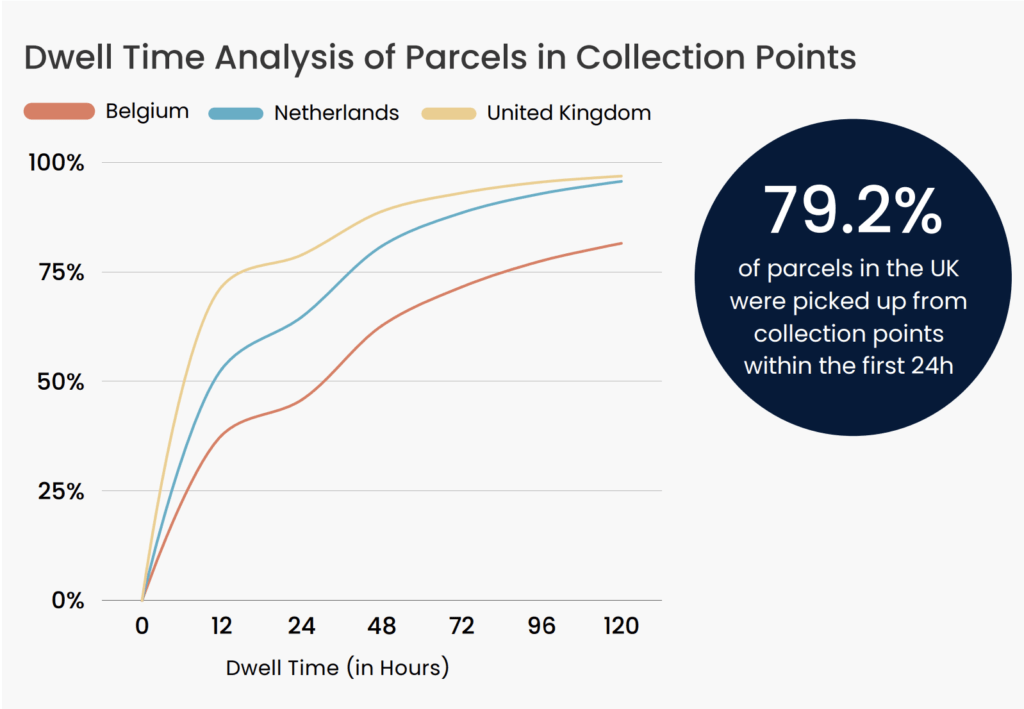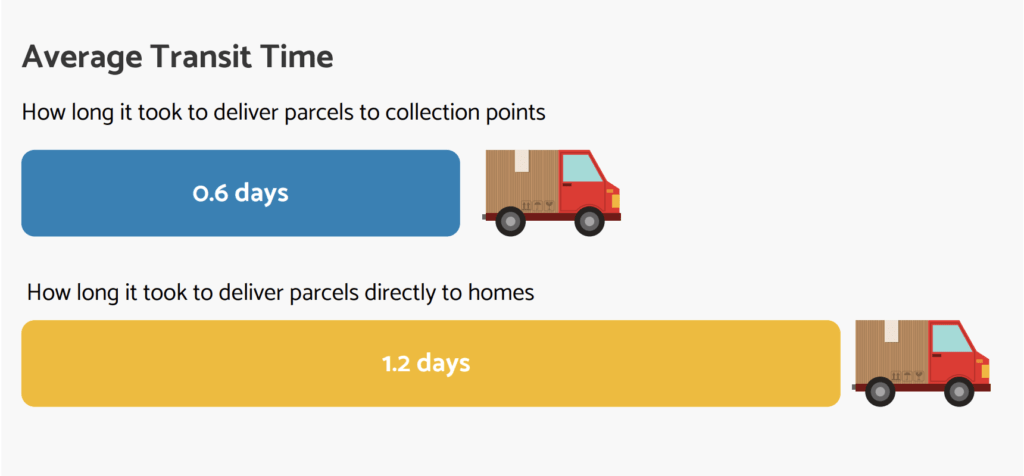The Use of Collection Points Around the World
Written by
Editorial TeamPublished on

E-commerce remains a highly popular means for people around the world to make purchases. In 2021, the value of online retail goods delivered globally reportedly reached around five million dollars. From all indications, this trend will only continue for the foreseeable future.
Online retail platforms typically offer two main delivery options: direct home delivery and other non-conventional methods, such as collection points. While the former option sees the goods brought straight to the customer’s doorstep, the latter involves the use of specially designated pick up points where orders are stored until they are picked up by customers.
Today, collection points have continued to grow in popularity around the world as customers are attracted to the flexibility, cost effectiveness and other advantages that they offer. In this article, we examine trends in collection points usage around the world.
Home Delivery Retains Its Top Spot Among Preferred Delivery Modes Globally
Home delivery may be the traditional and old-fashioned mode of parcel delivery, but most consumers around the world still prefer this method. This is the case especially in Africa and Latin America where cash remains the most prevalent mode of payment for goods and services. The two continents recorded rates of 98.3% and 99.4% respectively of home delivery customers.
Apart from these continents, North American and Asian consumers are predominantly opting for home deliveries as well. This choice is no doubt influenced by the relatively fast delivery of parcels in these areas in the wake of the pandemic. For example, the average transit time for the first delivery attempt in Singapore was 1.5 days after the pandemic.
Oceanian Customers Lead the World in Collection Points Demand
In the post-pandemic era, an increasing number of Oceanians are turning to e-commerce for their purchases. In just Q1 2021, over five million Australian households made e-commerce purchases on a monthly basis. Over the same period, New Zealand recorded a 27% rise in online purchases in comparison to the preceding year.
This spike in e-commerce patronage in Q1 2021 is in contrast to the slow growth that it recorded pre-COVID. Collection points are only a newly introduced delivery option in certain parts of Oceania such as New Zealand. Despite this fact, a tenth of customers in the continent prefer to receive their purchases through collection points.
Among Australian customers, collection points are widely viewed as a vital delivery option and collection point deliveries continue to experience growth in the country. Australia Post, DHL Holidays and New Zealand Post are some of the leading companies offering collection point deliveries on the continent.
Last-Mile Delivery in Europe Takes an Unconventional Turn
Today, customers expect better options and higher standards of service delivery from e-commerce companies. To meet these new demands, these companies are adopting more and more innovative solutions to meet their orders.
In particular, Pick-up and Drop-off (PUDO) points have become increasingly popular on the European continent with over 330,000 of these found in the area. This represents a growth rate of around 40% since 2019. A significant proportion of these are Automated Parcel Machines (APMs) which allow customers to receive a wide variety of goods including perishable items.
2021 Collection Point Usage in Europe at a Glance
For the past two years, the rate usage of collection points remained largely even across several European countries including the UK, France and Germany. However, France and Germany recorded a slight decrease in collection points in 2021 compared to the previous year, with around 1% of these points being closed down.
The reverse, however, was the case with the Netherlands which experienced a small (0.4%) boost in its collection points. This is largely due to a campaign by PostNL aimed at increasing collection point availability in the country. The company has invested heavily in this sector and aims to build 1500 of such facilities in the country in two years to come. It is hoped that this program would ease the transmission and reception of goods in the country.
Examining the Dwell Times of Packages in European Collection Points

Many logistics staff and experts are concerned about how much time their packages are kept at storage facilities en route to their destinations, known as dwell times. When these waits last too long, logistics companies and retailers are faced with losses in the long run. To reduce dwell times, logistics stakeholders adopt a variety of measures.
These include keeping customers informed of the progress of their inbound deliveries in real time. Customers are also given specific dates to expect the arrival purchases. With these strategies, logistics companies aim at increasing first-time delivery successes.
In 2021, European parcels recorded very short dwell times. In that year, the majority of European parcel collections were completed within a 24-hour period. This bears testimony to the effectiveness of sufficient numbers of easily-accessible collection points. The UK led the way with 79.2% of same day completions. Belgium and Germany come after with 45.7% and 54.4% respectively.
Saturday Morning Is the Preferred Delivery Time for Belgian Shoppers
Studies show that more Automated Parcel Machines (APMs) are needed to serve the European market. Most European countries have less than two APMs for every 10,000 residents. This data, coupled with the fact that APMs have been shown to be effective, suggests that a lot more of these machines may be installed in Europe in the near future.
In a rather strange phenomenon, most Belgian customers pick up their packages from collection points on Saturday mornings despite the fact that they have the option of doing this at all times on all the days of the week. This fact suggests that many of the collection points in the country are located in such places that they cannot be easily accessed by customers while going about their daily activities or during breaks from work. To offset this problem, logistics companies are negotiating with transport companies to establish collection points at train stations where they can easily be accessed by commuters.
Weekday Noons Are the Favored Time for Parcel Delivery in Germany
Most customers of German e-commerce companies have the luxury of choosing from a wide range of options regarding delivery times and methods. However, most of them prefer to have their deliveries made directly to their houses at noon. Only slightly higher than a tenth of German customers use collection point lockers.
Of these, the majority chooses to take their parcels at noon during weekdays. An explanation for this phenomenon is that most German collection points users pick their parcels up during their lunch breaks as they are most likely at work during weekdays.
Furthermore, most German customers choose not to go for pickups over the weekend although logistics companies typically keep their collection points open on weekends. This could be because the customers prefer to make their pickups while going to or returning from work or taking afternoon breaks instead of making trips to collection points on weekends when they have the time for leisure.
It Takes Twice As Long to Deliver to Collection Points As to Homes

Collection points have emerged as one of the fastest and most efficient modes of parcel delivery globally. The transit time or the amount of time it takes for packages to reach their destinations is very important to logistics companies.
Statistics show that while deliveries to collection points take 0.6 days on average, those made to customers’ homes take around 1.2 days. There are several reasons why collection points have become the option of choice for logistics companies today. First, with collection points, there is no question of delivery failure as customers can go and pick up their goods whenever they find convenient.
Another argument in favor of collection points is the relative cost-effectiveness of this delivery option. Slightly over half of German respondents to a KPMG survey reported that they chose to use collection points in order to save shipping costs. E-commerce goods cost significantly lower when they are delivered to collection points than when they are sent straight to customer’s homes. Last but not least, logistics companies can save costs by delivering large numbers of parcels to a collection point instead of making several trips to customers’ homes.
That being said, the direct home delivery option still remains popular with many customers around the world. In the future, both delivery options are sure to remain in use as logistics companies try to meet the various requirements and preferences of their customers around the world.
Wrapping Up
Today, an increasing number of online retailers and logistics companies are delivering their goods through collection points. This is hardly surprising as collection point deliveries are faster, cheaper and more flexible than traditional home deliveries.
Moving forward, logistics companies need to establish more of these collection points in areas that are easily accessible. This would enable customers to easily pick up their orders without having to disrupt their daily schedule. Furthermore, innovations such as Automated Parcel Machines (APMs) have made their appearance. Predictably, the top logistics services providers of the future will be those that provide the most accessible collection points to ease parcel delivery.
About Parcel Monitor
Parcel Monitor is a community initiated by e-commerce logistics enthusiasts at Parcel Perform. We aim to inspire the e-commerce logistics ecosystem to create a better delivery experience for everyone.
Parcel Monitor offers free parcel tracking across 900+ carriers globally on a single platform. Leveraging on our data and technology, we capture consumer trends, provide market visibility and derive industry insights while fostering collaboration across the entire e-commerce industry.
***
Get more valuable information by signing up for our newsletter!


